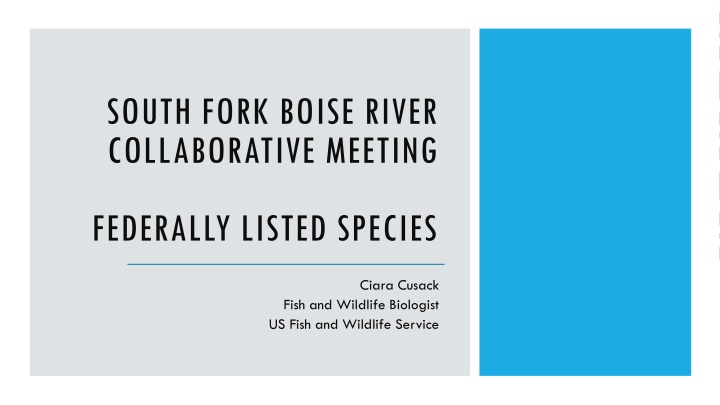
Collaborative Meeting for Species Conservation in South Fork Boise River
The collaborative meeting discusses federally listed species and the importance of conservation efforts to protect endangered and threatened species in the South Fork Boise River area. Various species, including Canada Lynx, North American Wolverine, Monarch Butterfly, Whitebark Pine, and Bull Trout, are highlighted along with updates on their status and conservation plans.
Download Presentation

Please find below an Image/Link to download the presentation.
The content on the website is provided AS IS for your information and personal use only. It may not be sold, licensed, or shared on other websites without obtaining consent from the author. If you encounter any issues during the download, it is possible that the publisher has removed the file from their server.
You are allowed to download the files provided on this website for personal or commercial use, subject to the condition that they are used lawfully. All files are the property of their respective owners.
The content on the website is provided AS IS for your information and personal use only. It may not be sold, licensed, or shared on other websites without obtaining consent from the author.
E N D
Presentation Transcript
SOUTH FORK BOISE RIVER COLLABORATIVE MEETING FEDERALLY LISTED SPECIES Ciara Cusack Fish and Wildlife Biologist US Fish and Wildlife Service
Section 7(a). Interagency Cooperation Federal Agency Actions and Consultations All other Federal agencies shall, in consultation with and with the assistance of the Secretary, utilize their authorities in furtherance of the purposes of this Act by carrying out programs for the conservation of endangered species and threatened species listed. Each Federal agency shall, in consultation with and with the assistance of the Secretary, ensure that any action authorized, funded, or carried out by such agency is not likely to jeopardize the continued existence of any endangered species or threatened species or result in the destruction or adverse modification of habitat of such species. ENDANGERED SPECIES ACT
PRELIMINARY POTENTIAL SPECIES (DEPENDENT ON FINAL ACTION AREA AND ANY FUTURE UPDATES) IPaC: Information for Planning and Consultation- Species List Action Area All areas to be affected directly or indirectly by the Federal action Species Canada Lynx (Lynx canadensis), Threatened North American Wolverine (Gulo gulo luscus), Proposed Threatened Monarch Butterfly (Danus plexippus), Candidate Whitebark Pine (Pinus albicalus), Threatened Bull Trout (Salvelinus confluentus), Threatened Critical Habitats Bull Trout Critical Habitat (Final)
Species Presence Trinity Lynx Analysis Unit (LAU) No recent detections Species Updates Draft Recovery Plan in progress CANADA LYNX
Species Presence Potential to occur within the Action Area depending on project scale Species Updates Species Status Assessment Addendum Completed Sept 28, 2023 Listing decision Nov 2023 NORTH AMERICAN WOLVERINE
Species Presence Potential to occur within the action area depending on project scale Milkweed has been observed Species Updates Proposed listing/proposed CH on national listing workplan to be completed FY 2024. Conservation recommendations MONARCH BUTTERFLY
Species Presence Potential to occur within the Action Area depending on project scale Species Updates Final rule went into effect on January 17, 2023 WHITEBARK PINE
Species Presence South Fork Boise River Throughout entire reach Tributaries Where access and adequate habitat/stream temperatures exist Bull Trout Critical Habitat South Fork Boise River Foraging, migratory and overwintering habitat Rattlesnake Creek and Little Rattlesnake Creek Spawning and Rearing Species Updates Species Status Assessment (SSA) is in progress BULL TROUT
BULL TROUT CRITICAL HABITAT 1. Springs, seeps, groundwater sources, and subsurface water connectivity. 2. Migratory habitats with minimal barriers. 3. An abundant food base. 4. Complex river, stream, lake, reservoir, and marine shoreline aquatic environments and processes with features such as large wood, side channels, pools, undercut banks and substrates, to provide a variety of depths, gradients, velocities, and structure. 5. Water temperatures ranging from 2 to 15 C (36 to 59 F), with adequate thermal refugia available for temperatures at the upper end of this range. 6. Substrates of sufficient amount, size, and composition to ensure success of egg and embryo overwinter survival, fry emergence, and young-of-the-year and juvenile survival. 7. A natural hydrograph, including peak, high, low, and base flows within historic and seasonal ranges or, if flows are controlled, they minimize departures from a natural hydrograph. 8. Sufficient water quality and quantity such that normal reproduction, growth, and survival are not inhibited. 9. Few or no nonnative predatory species present.
OTHER SPECIES TO CONSIDER Yellow-Billed Cuckoo (Coccyzus americanus), threatened While they aren't consistently found in the corridor, there have been some detections in the past. Bald and Golden Eagles Migratory Birds Native Species
Contact Information: QUESTIONS? Idaho Fish and Wildlife Office ciara_cusack@fws.gov


